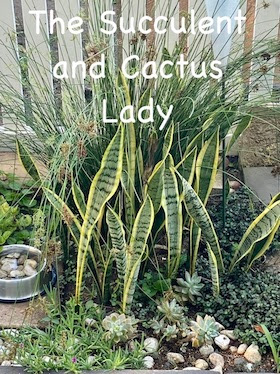Family: Crassulaceae
Common names: pig's ear (Eng.); plakkie, platjies, varkoorblare, varkoor, kouterie (Afr.)
I was lucky enough to find this lovely specimen at Sterlig Nursery in Roodepoort in January. It will be spending the winter inside with some of my other succulents and then, in spring, go into the new rock garden I'm planning.
This succulent plant has thick leaves which may vary from green to grey, often with a red line around the margin. Cotyledon orbiculata has five varieties, based on differences in leaf and flower shape. The variability of leaf size, shape and colour is also influenced by the immediate environment. Selected forms in cultivation have been given names such as 'Elk Horns' or 'Silver Waves'.
Flowering time is mostly in winter from June-August, but in the winter rainfall areas such as the Western Cape, it is often in midsummer. The colourful, hanging, tubular/bell-shaped flowers are carried in clusters on the ends of an elongated flower stalk. They are mostly orange-red , but yellow flowering forms are also occasionally found (Ernst van Jaarsveld pers. comm.).
Distribution
Cotyledon orbiculata is widespread throughout South Africa, but is usually confined to rocky outcrops in grassland fynbos and karoo regions. Black frost will damage the flowers, if planted in an unprotected spot, but the plant itself will tolerate moderate frosts.
Ecology
The brightly coloured flowers attract bees and birds, which feed on the nectar of the plant. The silver-grey leaves of some forms owe much of their attractive colouring to a powdery white coating which may assist in reflecting much of the sun's heat to prevent excessive water loss from the thick succulent leaves.
Uses and cultural aspects
This is a well-known medicinal plant. The fleshy part of the leaf is applied by many South Africans to soften and remove hard corns and warts. The Southern Sotho use a dried leaf as a protective charm for an orphan child and as a plaything. In the Willowmore District, the heated leaf is used as a poultice for boils and other accessible inflammations, in particular, earache.
Growing Cotyledon orbiculata
This is an easy to grow plant suitable for a number of places in the garden. Cotyledon orbiculata is an ideal plant for the rockery, but also grows well as a pot plant placed on a veranda (stoep). It will also add texture and form to the well-drained flower border. When planted as a pot plant, good drainage is important. It is often found in full sun, but also grows well in semi-shade under trees. This is an ideal plant for the water-wise gardener.
Plants may be grown from seed, but take care in the early stages not to over-water. The best time to sow the seed is in spring, and they should be kept moist, not waterlogged. Once the seedlings have reached 20-40 mm they can be transplanted.
Taking tip cuttings is the fastest method of increasing plant numbers; they must be kept fairly dry to prevent rotting. Once the tip cuttings have rooted they can be transplanted in a medium of 2 parts gravel to 1 part compost.
This plant has few pests, but it may be attacked by snails in the garden.
.
About me

🌿 I've been gardening ever since a child, when I spent time with my father in his vegetable garden. But my fascination with Echeverias started in the 1980's, when my father gave me a pot with five Echeverias, which turned out to be E. imbricata. At first I wasn't much interested in them and planted them in some obscure corner of the garden and completely forgot about them. How great was my surprise when, a couple of months later, I noticed that they had spread and made a beautiful display - I was hooked!
Pages
Monday, 20 April 2015
Subscribe to:
Post Comments (Atom)





No comments:
Post a Comment